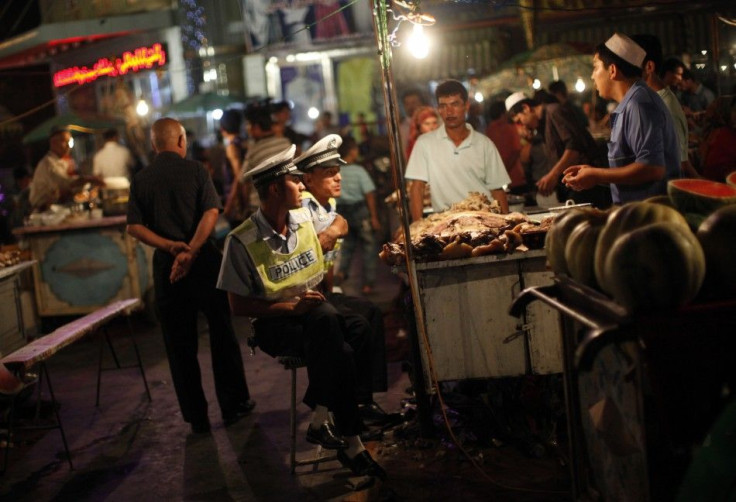Analysis: Far west attacks expose violence's homegrown roots

The biggest threat to China's grip on its ethnically divided far western frontier comes from homegrown anger exploding in violence, not from Pakistan-based terrorists officials have blamed for the latest bloodshed.
China said ringleaders of the separatist "East Turkestan Islamic Movement" (ETIM) who trained in Pakistan orchestrated the assault on Sunday that killed six in Kashgar city, Xinjiang region, where many Muslim Uighurs resent the presence of Han Chinese people.
The Uighur (pronounced "Wee-gur") are a Turkic-speaking people who form a minority in Xinjiang, and are culturally closer to ethnic groups across central Asia and Turkey than the Han Chinese who make the vast majority of China's population.
Still, many observers doubt the attack was a blow from abroad by ETIM, which they said was struggling, in disarray, and even outright defunct.
Instead, the causes of -- and possibly the cure for -- ethnic conflict lie mainly within China, they said.
"All conversations I have had with people from China and Pakistan suggest a high degree of skepticism about the real viability of ETIM," said Andrew Small, a researcher at the German Marshall Fund think tank in Brussels who studies China's ties with Pakistan and often visits both countries.
"I don't believe that China really sees (ETIM) as a credible threat. Of course, they would always want to blame these things on foreign elements to deflect from domestic problems," he said.
The recent attacks show China faces a largely homegrown brew of ethnic divisions and Uighur frustration in Xinjiang that can cause primitive spasms of violence against Han Chinese people and government targets.
"It's not based on an organization, but on a group of people with a shared desire to trigger an incident against the government and against Han people," said Yang Shu, a professor at Lanzhou University in northwest China who researches Islamist and separatist violence, referring to recent patterns of unrest in Xinjiang.
Since Uighur rioting in 2009, China has accelerated investments in Xinjiang hoping to create jobs and defuse ethnic volatility.
But experts said economic growth alone will not defuse Uighur resentment, which rests on a belief that their homeland is being exploited and overwhelmed by Han Chinese. Uighur separatists often call their homeland East Turkestan.
"They (Uighurs) feel like what is theirs, economically and culturally, is being taken away from them," said Tom Cliff, a graduate student at the Australian National University in Canberra who spent over three years in Xinjiang, now the subject of his research.
"They feel like they're trapped, because there's no way of speaking to the government."
THE PAKISTAN CONNECTION
The claimed Pakistani link to the killings in Kashgar may nonetheless give Beijing more leverage in pressing Islamabad to chase down exiled Uighur militants, mostly based in unruly tribal areas near Afghanistan.
Xinjiang sits next to south and central Asia, and China sees it as a vital bulwark in this volatile part of the world, making it all the more jumpy about unrest there.
The Chinese government says the militants pose a real threat. In May, the deputy minister of public security, Meng Hongwei, said there were signs that Uighur "East Turkestan terrorists" were returning from central Asia to China, the Xinhua news agency reported.
But few experts see them as capable of striking in Xinjiang. Rahimullah Yusufzai, a Pakistani expert, said Chinese officials told him there were only between 30 and 80 Uighur militants in Pakistan's tribal areas.
There is even uncertainty about whether the ETIM still operates as an effective organization. After a key leader of the group was killed in 2003, its activities went into decline.
"The ETIM seems to have faded out with a whimper, rather than a bang," Andrew McGregor, a Toronto-based security analyst wrote in a Jamestown Foundation report last year.
Some experts believe the organization reformed under another name, the Turkestan Islamic Party, which claimed to be behind attacks in China before the 2008 Olympic Games in Beijing.
"The ETIM has a very narrow support and sympathizer base, and most of its operatives have been killed or captured by the Chinese," said Rohan Gunaratna, an expert on terrorism at Nanyang Technological University in Singapore.
Uighurs generally do not support militant Islamic creeds, but more of them have embraced stricter observation of the religion over past years.
HOMEGROWN WOES
Even if ETIM or another exiled Uighur group provided ideological inspiration for recent attacks, the incidents themselves were relatively basic, relying on knives and homemade explosives, and appeared to be isolated.
"I call it a trend of localization and disorganization," said Lanzhou University's Yang.
"The people involved tend to be local residents, without any substantive links to people abroad."
In the worst bloodshed in Xinjiang in recent years, a protest in July 2009 by Uighurs in the regional capital Urumqi gave way to street attacks that killed nearly 200 people, many of them Han Chinese residents hacked by Uighur men with knives and cleavers.
"Xinjiang faces some incidents that are terror attacks, but some are more like ethnic hate crimes," said Jiang Zhaoyong, a Beijing-based commentator and former reporter who has studied Xinjiang for many years and often travelled there.
Since that unrest, China has sought to boost development in Xinjiang and vowed greater job opportunities, especially for Uighurs.
But discontent, and the violence it can inspire, will not easily disappear. Experts pointed to the persistence of a Uighur "underclass", and deep-rooted cultural and religious differences. Some say that whether it is economic opportunity, greater political rights or real self-rule, the drive for a solution must come from China.
"Economic development can reduce some conflicts and improve people's livelihoods, but it cannot directly resolve these basic problems of ethnic stability and conflict," said Yang.
© Copyright Thomson Reuters 2024. All rights reserved.











